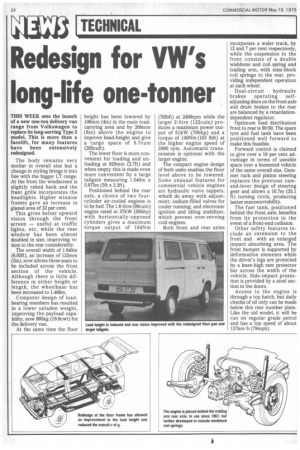Redesign for VW's long-life one-tonner
Page 26

If you've noticed an error in this article please click here to report it so we can fix it.
THIS WEEK sees the launch of a new one-ton delivery van range from Volkswagen to replace its long-serving Type 2 model. This is more than a facelift, for many features have been extensively redesigned.
The body remains very similar in overall size but a change in styling brings it into line with the bigger LT range. At the front the windscreen is slightly raked back and the front grille incorporates the headlights. Higher window frames gave an increase in glazed area of 22 per cent.
This gives better upward vision through the front screen — useful at traffic lights, etc, while the rear window has been almost doubled in size, improving vision to the rear considerably.
The overall width of 1.845m (6.05ft), an increase of 125mm (5in), now allows three seats to be included across the front section of the vehicle. Although there is little difference in either height or length, the wheelbase has been increased to 1.460m.
Computer design of loadbearing members has resulted in a lower unladen weight, improving the payload capability, now 995kg (19.6cwt) for the delivery van.
At the same time the floor height has been lowered by 100mm (4in) in the main loadcarrying area and by 200mm (8in) above the engine to improve head-height and give a cargo space of 5.7cum (203cuft).
The lower floor is more convenient for loading and unloading at 825mm (2.7ft) and when empty this is made even more convenient by a large tailgate measuring 1.540m x 0.975m (5ft x 3.2ft).
Positioned behind the rear axle, a choice of two fourcylinder air-cooled engines is to be had. The 1.6-litre (98cuin) engine rated at 37kW (50bhp) with horizontally-opposed cylinders gives a maximum torque output of 104Nm (761bft) at 2400rpm while the larger 2-litre (122cuin) produces a maximum power output of 51kW (70bhp) and a torque of 140Nm (103 lbft) at the higher engine speed of 3000 rpm. Automatic transmission is optional with the larger engine.
The compact engine design of both units enables the floor level above to be lowered. Some unusual features for commercial vehicle engines are hydraulic valve tappets, which do away with adjustment; sodium-filled valves for cooler running; and electronic ignition and idling stabilizer, which prevent over-revving cold engines.
Both front and rear axles incorporate a wider track, by 12 and 7 per cent respectively, while the suspension to the front consists of a double wishbone and coil spring and trailing arm, with mini-block coil springs to the rear, providing independent operation at each wheel.
Dual-circuit hydraulic brakes operating selfadjusting discs on the front axle and drum brakes to the rear are balanced by a retardationdependent regulator.
Optimum load distribution front to rear is 50:50. The spare tyre and fuel tank have been positioned well forward to make this feasible.
Forward control is claimed to give over a 10 per cent advantage in terms of useable space over a bonneted vehicle of the same overall size. Gemmer rack and pinion steering replaces the previous camand-lever design of steering gear and allows a 10.7m (35.1 ft) turning circle, producing better manoeuvrability.
The fuel tank, positioned behind the front axle, benefits_ from its protection in the event of a front-end collision.
Other safety features include an extension to the front and with an enlarged impact absorbing area. The front bumper is supported by deformation elements while the driver's legs are protected by a knee-high ram protector bar across the width of the vehicle. Side-impact protection is provided by a steel section in the doors.
Access to the engine is through a top hatch, but daily checks of oil only can be made below this rear number plate. Like the old model, it will be run on regular grade petrol and has a top speed of about 127km/h (79mph).




















































































































